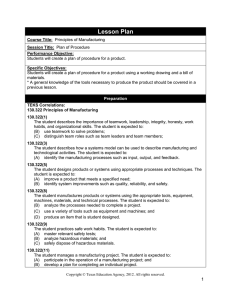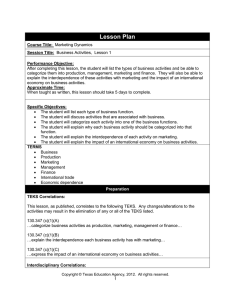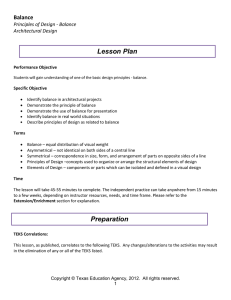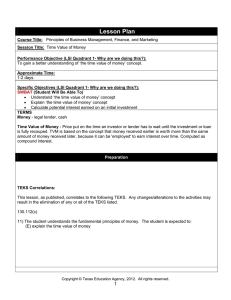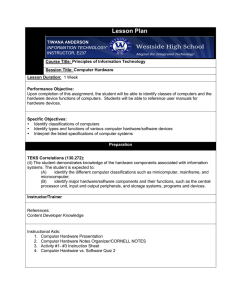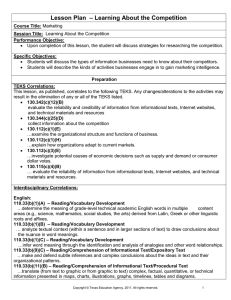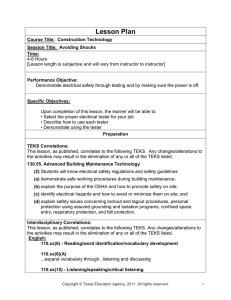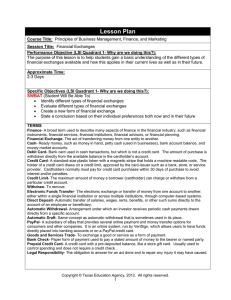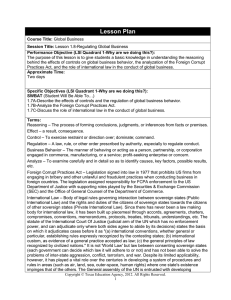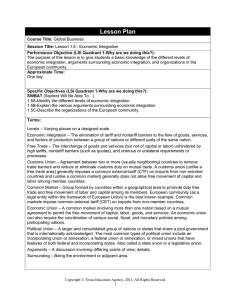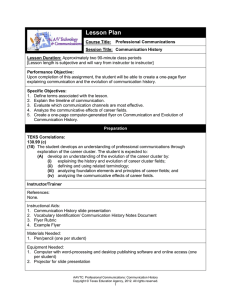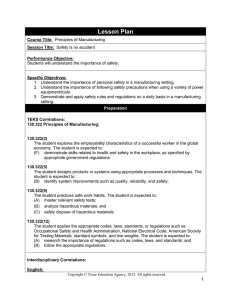Lesson Plan
advertisement
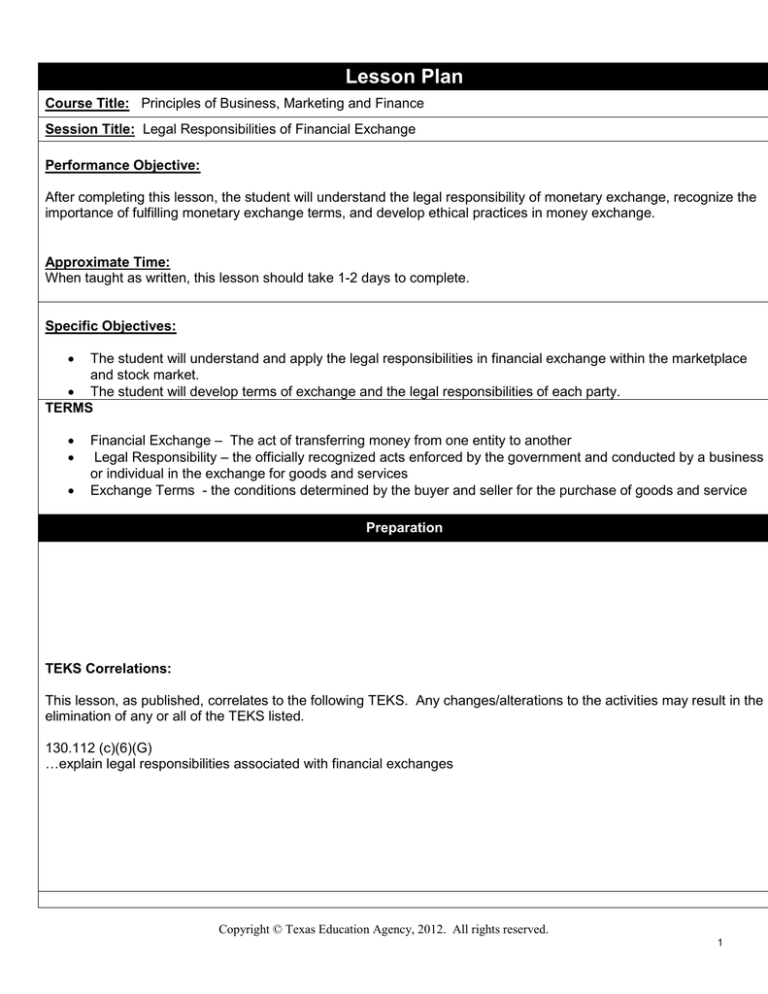
Lesson Plan Course Title: Principles of Business, Marketing and Finance Session Title: Legal Responsibilities of Financial Exchange Performance Objective: After completing this lesson, the student will understand the legal responsibility of monetary exchange, recognize the importance of fulfilling monetary exchange terms, and develop ethical practices in money exchange. Approximate Time: When taught as written, this lesson should take 1-2 days to complete. Specific Objectives: The student will understand and apply the legal responsibilities in financial exchange within the marketplace and stock market. The student will develop terms of exchange and the legal responsibilities of each party. TERMS Financial Exchange – The act of transferring money from one entity to another Legal Responsibility – the officially recognized acts enforced by the government and conducted by a business or individual in the exchange for goods and services Exchange Terms - the conditions determined by the buyer and seller for the purchase of goods and service Preparation TEKS Correlations: This lesson, as published, correlates to the following TEKS. Any changes/alterations to the activities may result in the elimination of any or all of the TEKS listed. 130.112 (c)(6)(G) …explain legal responsibilities associated with financial exchanges Copyright © Texas Education Agency, 2012. All rights reserved. 1 Interdisciplinary Correlations: English: 110.31 (b)(21)(B) … organize information gathered from multiple sources to create a variety of graphics and forms (e.g., notes, learning logs)… 110.31 (b)(22)(B) …evaluate the relevance of information to the topic and determine the reliability, validity, and accuracy of sources (including Internet sources) by examining their authority and objectivity… 110.31 (b)(23)(C) … use graphics and illustrations to help explain concepts where appropriate… 110.31 (b)(23)(D) … use a variety of evaluative tools (e.g., self-made rubrics, peer reviews, teacher and expert evaluations) to examine the quality of the research… Occupational Correlation (O*Net - http://www.onetonline.org/) Financial Manager 11-3031.2 Similar Job Titles: Branch Manager, Banking Center Manager (BCM), Service Center Manager, Collections Vice President, Consumer Lending Vice President, Consumer Loan Manager, Electronic Services Vice President, Lending Manager, Loan Servicing Vice President, Loan Systems Director Tasks: Establish and maintain relationships with individual or business customers or provide assistance with problems these customers may encounter. Examine, evaluate, or process loan applications. Plan, direct, or coordinate the activities of workers in branches, offices, or departments of establishments, such as branch banks, brokerage firms, risk and insurance departments, or credit departments. Oversee the flow of cash or financial instruments. Recruit staff members and oversee training programs. Network within communities to find and attract new business. Approve, reject, or coordinate the approval or rejection of lines of credit or commercial, real estate, or personal loans. Prepare financial or regulatory reports required by laws, regulations, or boards of directors. Establish procedures for custody or control of assets, records, loan collateral, or securities to ensure safekeeping. Review collection reports to determine the status of collections and the amounts of outstanding balances. (Soft) Skills: Active listening, speaking, writing, critical thinking, judgment and decision making, time management Copyright © Texas Education Agency, 2012. All rights reserved. 2 Teacher Preparation: Teacher will review the terms in the outline, presentation slides and handouts to become familiar with lesson. Teacher should locate and evaluate various resources and websites before the lesson. Teacher will have assignments and website information ready to distribute to students. References: Eggland, S. S., Dlabay, L. R., & Burrow, J. L. (2004). Intro to Business 5th Edition. Mason: ThompsonSouthwestern. Farese, L. S., Kimbrell, G., & Woloszyk, C. A. (2002). Marketing Essentials 3rd Edition. Woodland Hills: Glencoe/McGraw Hill. Ryan, J. S. (2006). Managing Your Personal Finances. Mason: South-Western Cengage Learning. Instructional Aids: 1. Display for presentation, websites for assignments and class discussion Materials Needed: 1. Printer paper 2. Assignments and website information ready to distribute to students 3. Copy of instructions and rubric for each student Equipment Needed: 1. Computer with presentation and Internet access 2. Projector to review presentation and Internet sites 3. Computers for students to conduct research and collect data for projects Learner Preparation: Monetary exchange occurs daily to maintain a standard of living and satisfy the needs and wants of society. However, the legal responsibilities of participating in financial exchange are crucial to the overall health of the economy. Therefore, understanding and fulfilling the legal responsibilities is imperative in exchange. Ask students to provide examples of a purchase they recently made or an item they sold to someone. Inquire about the experience of the exchange and the outcome. Have students share an instance of unethical or illegal financial exchange they have witnessed or experienced. Introduction Introduction (LSI Quadrant I): SHOW: Show students a picture of a popular or sought after item relevant to their age. (phone, car, food, etc.) ASK: Ask students what is necessary to acquire these items. Copyright © Texas Education Agency, 2012. All rights reserved. 3 SAY: Explain how a desire for a product or service requires the ability to provide the monetary means necessary to purchase it. ASK: Ask students if the seller should sell the product for a price higher than its value. SAY: Explain how it is important for the seller and the buyer to identify the value and agree on the monetary exchange. Outline Outline (LSI Quadrant II): Instructors can use the presentation, slides, handouts, and note pages in conjunction with the following outline. MI Outline I. Discovery A. Ask students to provide examples of a purchase they recently made or an item they sold to someone B. Ask students of a time they did not believe an exchange made was legal or ethical Notes to Instructor Share personal experiences of exchange, both good and bad. II. Introduction A. Why is legal financial exchange important 1. Discuss economic impact 2. Review legal factors associated with exchange 3. Identify personal responsibility of legal exchange Use the terms listed to review definitions and locate websites discussing specific laws or legal cases related to monetary exchange. III. Guided Practice A. Provide students with an article or document related to legal exchange B. Discuss the information as a whole group to identify new knowledge obtained Use a site such as http://www.sec.gov/about/whatwedo.shtml to locate a related article or document regarding exchange IV. Independent Practice A. Financial Exchange Laws – Complete assignment in pairs or independently Use the instructions and rubric to evaluate student’s performance V. Extension A. What are the Terms? – complete independently to review laws, determine terms, and practice formal writing Use the enrichment activity to expand student learning and evaluation of information Copyright © Texas Education Agency, 2012. All rights reserved. 4 VI. Summary A. Review lesson objectives B. Check for understanding Verbal Linguistic Logical Mathematical Visual Spatial Musical Rhythmic Bodily Kinesthetic Conduct a class discussion to review information obtained from the lesson and revisit areas lacking comprehension Intrapersonal Interpersonal Naturalist Existentialist Application Guided Practice (LSI Quadrant III): Ask students to review the article provided related to legal financial exchange and identify an unknown fact or element within the text. Discuss the article and the importance of the information presented related to the impact on the economy and the practice of exchange overall. Independent Practice (LSI Quadrant III): This project will be evaluated using the assigned rubric for “Financial Exchange Laws.” Summary Review (LSI Quadrants I): What are considerations you should make when purchasing an item in the future? Name one of the legal responsibilities a business has when selling a product. What will you do differently upon making a purchase? Evaluation Informal Assessment (LSI Quadrant III): Instructor should observe the work ethic of individuals involved in class discussions and the independent practice activity. Formal Assessment (LSI Quadrant III, IV): Students will be evaluated on their “Financial Exchange Laws” by using the assigned rubric. Copyright © Texas Education Agency, 2012. All rights reserved. 5 Extension Extension/Enrichment (LSI Quadrant IV): What are the Terms? Student Directions You are a consumer interested in making a large purchase of stock or a product. It is your responsibility to identify the terms of the purchase you are about to make. Research stock or a product of choice to identify the terms of purchase. Review financial exchange laws to ensure the purchase and terms are legal. Then write a formal letter to the stock or product seller identifying your purchase choice and the terms necessary to make the exchange. Outline any laws that must be considered for the purchase. Finally, request an appointment to finalize the purchase. Copyright © Texas Education Agency, 2012. All rights reserved. 6 Principles of Business, Marketing, and Finance Lesson 39 Student Directions Independent Practice (LSI Quadrant III): Financial Exchange Laws 1. Research current laws related to financial exchange within the stock market or consumer product/service purchasing. 2. Identify the origination of the law and the key elements affecting businesses and consumers. 3. Create a poster highlighting the legal elements and give suggestions for ensuring a business and consumer abide by these requirements. 4. Include the following on the poster a. Name of law b. Origination date c. Important elements (listed as bullets) d. Suggestions for businesses and consumers e. Graphics to reinforce topic information 5. Share findings with class as a formal presentation and post visual throughout room as a reminder of these legal responsibilities. Copyright © Texas Education Agency, 2012. All rights reserved. 7 Independent Practice (LSI Quadrant III) Financial Exchange Laws Rubric 20 15 CATEGORY 10 5 Presentation Well-rehearsed with smooth delivery that holds audience attention. Rehearsed with fairly smooth delivery that holds audience attention most of the time. Delivery not smooth, Delivery not smooth but able to maintain and audience interest of the attention often lost. audience most of the time. Attractiveness Makes excellent use of text, color, graphics, effects, etc. to enhance the poster. Makes good use of text, color, graphics, effects, etc. to enhance the poster. Makes use of text, color, graphics, effects, etc., but occasionally these distract from the poster content. Use of text, color, graphics, effects etc., but these often distract from the poster content. Content Covers topic indepth with details and examples. Subject knowledge is excellent. Includes essential knowledge about the topic. Subject knowledge appears to be good. Includes essential information about the topic but there are 1-2 factual errors. Content is minimal OR there are several factual errors. Organization Content is well organized using headings or bulleted lists to group related material. Uses headings or bulleted lists but the overall organization of topics appears flawed. Content is logically organized for the most part. There was no clear or logical organizational structure; just lots of facts. Originality Poster shows a large amount of original thought. Ideas are creative and inventive. Poster shows some original thought. Work shows new ideas and insights. Uses other people's ideas (giving them credit), but there is little evidence of original thinking. Uses other people's ideas, but does not give them credit. Total Points Earned _______ Copyright © Texas Education Agency, 2012. All rights reserved. 8
